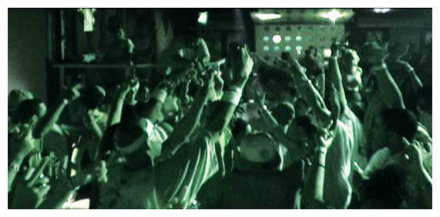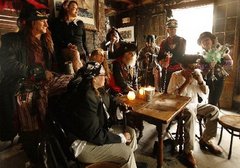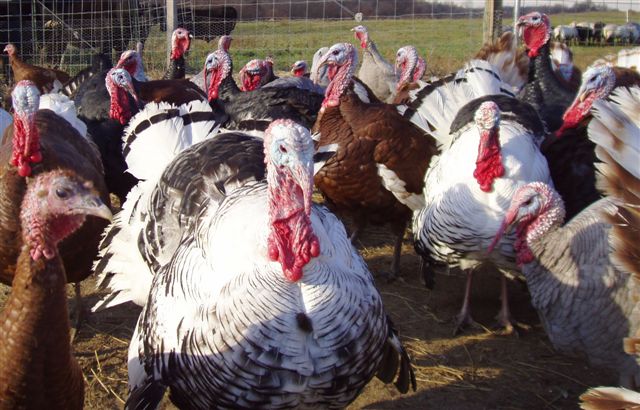AgriCulture bloggers Peter Davies and Mark Scherzer are the owners of Turkana Farms in Germantown, NY. This week Mark writes.

We have returned from our glorious annual escape to the French Quarter Festival in New Orleans, with renewed energy to plunge back into the busy spring activities of the farm. Peter has written about New Orleans as a place isolated from an agricultural hinterland, with an inhospitable environment for cultivation of the sorts of flora and produce we're accustomed to. But there's an "on the other hand" to be noted about the city. Whatever its relationship to the vegetable, it has an infectious and lustily full-throated spirit of indulgence with regard to our own "animal" natures and elemental desires. That elemental spirit is evident in the prodigious quantities of food and drink so extravagantly prepared and avidly consumed. The spirit is inescapable as one strolls past the honky-tonk strip joints on Bourbon Street. And you feel this outrageous spirit when you listen to music as it is experienced there. Unless you're going to rock concerts or mosh pits, a public musical performance in New York is likely to find the vast majority of the audience seated, attentively listening, making judgments about the performance and applauding politely. In New Orleans, a big proportion of the audience, and sometimes virtually everybody, will be up dancing or at least swaying and clapping their hands to the music. When a marching band passes in a New York parade, it usually leaves its audience standing where it found them; in New Orleans, likely as not, many in the crowd will peel off, form a dancing "second line," and caper off with the band. Their distinctive style of moving to the beat can be entrancing.

Festivals, which seem to occur in New Orleans every few weeks, are the sorts of events the city does best. All cultures have events in which people assemble to enjoy arts in crowds, but New Orleans has made a specialty of it. And watching the dynamics of the crowd is fascinating to me. Just as spending time with our animals has given me repeated moments of insight into how much like humans they really are, spending time with large herds of humans engaged in our collective activities has reminded me of the reciprocal truth: that is, how much like our animals we actually are. The human crowd, it turns out, has a dynamic not all that different from that of the sheep herd or turkey flock.

Perhaps one of the most memorable episodes of this trip was our dinner at Galatoire's, the old Creole war horse of a restaurant on Bourbon Street. It usually seems like a very staid place, where the New Orleans elite meet and everyone has their favorite waiters. On this visit, a "Pirate" social organization, perhaps a Mardi Gras crew, was having its annual dinner, and for some reason the management had seated the group not in an upstairs private retreat, but in the middle of the main downstairs dining room. A table of 42 middle to late middle-aged prosperous-looking men, some in pirate regalia or with false stitches pasted on their cheeks, sat at one long table. At two separate tables sat their wives, a few children, and other non-members, presumably business associates, friends or relatives. At first this raucous gathering in the center of the dining room seemed quite intrusive, and we wondered whether we should have gone somewhere else. Periodically, for no apparent reason, the group would erupt and begin bellowing in unison, a few more members joining each time, in a deep sonorous "whoaaaaaah." They were attracting attention to themselves, and the bellows would arise at seemingly random intervals. But for us, coming from the farm, where a chorus of nonsense syllables arises from almost all assemblages of farm animals, only to die out a few moments later, it all began to seem strangely familiar, and far more entertaining than annoying. Looking at the "Pirates" table, I thought "cow pasture," the cows are bellowing for something they want. And as we enjoyed our gumbo and crab and watched, the group proceeded to a call and response routine, in which one "pirate" asked what their favorite letter was, and because the letter was, undoubtedly for reasons of the sound it made, "R," they replied with a sonorous, elongated arrrrrrrrrrrrrrr. And this reminded me of our turkeys, who gobble incessantly in response to particular oral cues. As they finished their main course, the "Pirates" and guests began circulating around the tables, visiting one another in a happy babble of greeting, touching, and conversing. Again, I was reminded of our turkeys. The toms preen, strut, and dance to gain the admiration of the hens, and our "Pirate" toms and hens seemed no less engaged in that kind of socialization. Ultimately, the "Pirates" united in song. One couldn't generally understand the lyrics, but then the content didn't really seem to matter that much. Seen through the prism of the barnyard, the entire event seemed more about display, demonstrating unity as members of the group, and simply soaking up the atmosphere of the particular time and place than it was about any substantive purpose. This is both basic animal and basic human instinct. The daily afternoon gatherings of our turkeys just before they are to enter their perching coop is hardly any different.

Next week our flock of Naragansett, Bourbon Red, Spanish Black, and Holland White birds will arrive by U.S. Mail as day-old poults from the hatchery. They will, within minutes of arriving, begin socializing and milling about in what Peter calls "the eternal slumber party," and within a few weeks will be vocalizing in unison expressing the deeply ingrained behaviors of their animal group. By summer, we'll be laughing at their Shriner-parade-like milling about and their display dances as if they are in some way incomprehensible activities. Yet the rhythmical ritual song of the human, the dance of the social group, is hardly any different.









